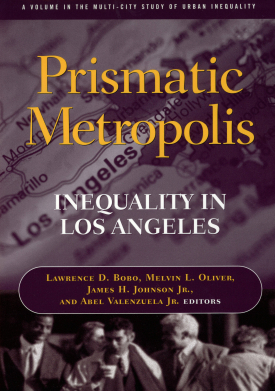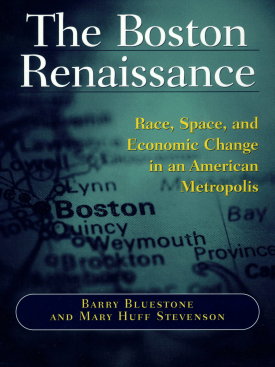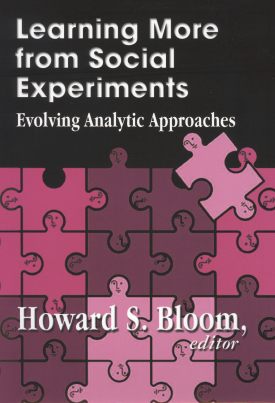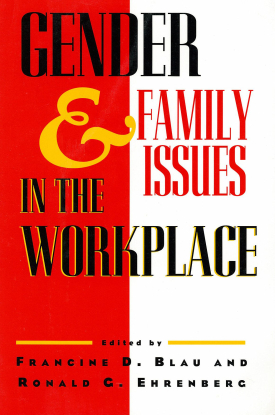
Prismatic Metropolis
About This Book
This book cuts through the powerful mythology surrounding Los Angeles to reveal the causes of inequality in a city that has weathered rapid population change, economic restructuring, and fractious ethnic relations. The sources of disadvantage and the means of getting ahead differ greatly among the city's myriad ethnic groups. The demand for unskilled labor is stronger here than in other cities, allowing Los Angeles's large population of immigrant workers with little education to find work in light manufacturing and low-paid service jobs.
A less beneficial result of this trend is the increased marginalization of the city's low-skilled black workers, who do not enjoy the extended ethnic networks of many of the new immigrant groups and who must contend with persistent negative racial stereotypes.
Patterns of residential segregation are also more diffuse in Los Angeles, with many once-black neighborhoods now split evenly between blacks, Hispanics, Asians, and other minorities. Inequality in Los Angeles cannot be reduced to a simple black-white divide. Nonetheless, in this thoroughly multicultural city, race remains a crucial factor shaping economic fortunes.
LAWRENCE D. BOBO is professor of sociology and Afro-American studies at Harvard University.
MELVIN L. OLIVER is vice president of the Ford Foundation. He is responsible for overseeing the Asset Building and Community Development Program.
JAMES H. JOHNSON JR. is William Rand Kenan Jr. Distinguished Professor of Management, Sociology, and Public Policy and director of the Urban Investment Strategies Center in the Kenan Institute in the Kenan-Flager Business School at the University of North Carolina at Chapel Hill.
ABEL VALENZUELA JR. is assistant professor of urban planning and Chicana/o studies at the University of California, Los Angeles. He is also associate director of the Center for the Study of Urban Poverty, Institute for Social Science Research.
CONTRIBUTORS: Elisa Jayne Bienenstock, Camille Zubrinksi Charles, Walter C. Farrell Jr., Jennifer L. Glanville, Elizabeth Gonzalez, David M. Grant, Tarry Hum, Devon Johnson, Michael I. Lichter, Julie E. Press, Michael A. Stoll, Susan A. Suh, Jennifer A. Stoloff.
A Volume in the Multi-City Study of Urban Inequality
RSF Journal
View Book Series
Sign Up For Our Mailing List
Apply For Funding

The Boston Renaissance
About This Book
This volume documents metropolitan Boston's metamorphosis from a casualty of manufacturing decline in the 1970s to a paragon of the high-tech and service industries in the 1990s. The city's rebound has been part of a wider regional renaissance, as new commercial centers have sprung up outside the city limits. A stream of immigrants have flowed into the area, redrawing the map of ethnic relations in the city. While Boston's vaunted mind-based economy rewards the highly educated, many unskilled workers have also found opportunities servicing the city's growing health and education industries.
Boston's renaissance remains uneven, and the authors identify a variety of handicaps (low education, unstable employment, single parenthood) that still hold minorities back. Nonetheless this book presents Boston as a hopeful example of how America's older cities can reinvent themselves in the wake of suburbanization and deindustrialization.
BARRY BLUESTONE is the Russell B. and Andr`ee B. Stearns Trustee Professor of Political Economy and director of the Center for Urban and Regional Policy at Northeastern University.
MARY HUFF STEVENSON is associate professor of economics at the University of Massachusetts, Boston, and senior fellow at its McCormack Institute of Public Affairs.
A Volume in the Multi-City Study of Urban Inequality
Download
RSF Journal
View Book Series
Sign Up For Our Mailing List
Apply For Funding

Learning More From Social Experiments
About This Book
Policy analysis has grown increasingly reliant on the random assignment experiment—a research method whereby participants are sorted by chance into either a program group that is subject to a government policy or program, or a control group that is not. Because the groups are randomly selected, they do not differ from one another systematically. Therefore any differences between the groups at the end of the study can be attributed solely to the influence of the program or policy. But there are many questions that randomized experiments have not been able to address. What component of a social policy made it successful? Did a given program fail because it was designed poorly or because it suffered from low participation rates? In Learning More from Social Experiments, editor Howard Bloom and a team of innovative social researchers profile advancements in the scientific underpinnings of social policy research that can improve randomized experimental studies.
Using evaluations of actual social programs as examples, Learning More from Social Experiments makes the case that many of the limitations of random assignment studies can be overcome by combining data from these studies with statistical methods from other research designs. Carolyn Hill, James Riccio, and Bloom profile a new statistical model that allows researchers to pool data from multiple randomized-experiments in order to determine what characteristics of a program made it successful. Lisa Gennetian, Pamela Morris, Johannes Bos, and Bloom discuss how a statistical estimation procedure can be used with experimental data to single out the effects of a program’s intermediate outcomes (e.g., how closely patients in a drug study adhere to the prescribed dosage) on its ultimate outcomes (the health effects of the drug). Sometimes, a social policy has its true effect on communities and not individuals, such as in neighborhood watch programs or public health initiatives. In these cases, researchers must randomly assign treatment to groups or clusters of individuals, but this technique raises different issues than do experiments that randomly assign individuals. Bloom evaluates the properties of cluster randomization, its relevance to different kinds of social programs, and the complications that arise from its use. He pays particular attention to the way in which the movement of individuals into and out of clusters over time complicates the design, execution, and interpretation of a study.
Learning More from Social Experiments represents a substantial leap forward in the analysis of social policies. By supplementing theory with applied research examples, this important new book makes the case for enhancing the scope and relevance of social research by combining randomized experiments with non-experimental statistical methods, and it serves as a useful guide for researchers who wish to do so.
HOWARD S. BLOOM is chief social scientist at MDRC.
CONTRIBUTORS: Johannes M. Bos, Lisa A. Gennetian, Carolyn J. Hill, Charles Michalopoulos, Pamela A. Morris, James A. Riccio.
RSF Journal
View Book Series
Sign Up For Our Mailing List
Apply For Funding

Gender and Family Issues in the Workplace
About This Book
Today, as married women commonly pursue careers outside the home, concerns about their ability to achieve equal footing with men without sacrificing the needs of their families trouble policymakers and economists alike. In 1993 federal legislation was passed that required most firms to provide unpaid maternity leave for up to twelve weeks. Yet, as Gender and Family Issues in the Workplace reveals, motherhood remains a primary obstacle to women's economic success. This volume offers fascinating and provocative new analyses of women's status in the labor market, as it explores the debate surrounding parental leave: Do policies that mandate extended leave protect jobs and promote child welfare, or do they sidetrack women's careers and make them less desirable employees?
An examination of the disadvantages that women—particularly young mothers—face in today's workplace sets the stage for the debate. Claudia Goldin presents evidence that female college graduates are rarely able to balance motherhood with career track employment, and Jane Waldfogel demonstrates that having children results in substantially lower wages for women. The long hours demanded by managerial and other high powered professions further penalize women who in many cases still bear primary responsibility for their homes and children. Do parental leave policies improve the situation for women? Gender and Family Issues in the Workplace offers a variety of perspectives on this important question. Some propose that mandated leave improves women's wages by allowing them to preserve their job tenure. Other economists express concern that federal leave policies prevent firms and their workers from acting on their own particular needs and constraints, while others argue that because such policies improve the well-being of children they are necessary to society as a whole. Olivia Mitchell finds that although the availability of unpaid parental leave has sharply increased, only a tiny percentage of workers have access to paid leave or child care assistance. Others caution that the current design of family-friendly policies may promote gender inequality by reinforcing the traditional division of labor within families.
Parental leave policy is a complex issue embedded in a tangle of economic and social institutions. Gender and Family Issues in the Workplace offers an innovative and up-to-date investigation into women's chances for success and equality in the modern economy.
FRANCINE D. BLAU is Frances Perkins Professor of Industrial and Labor Relations at Cornell University and research associate of the National Bureau of Economic Research in Cambridge, Massachusetts. At Cornell University, she is also research director of the School of Industrial and Labor Relations, director of the Institute for Labor Market Policy, faculty associate of the Cornell Employment and Family Careers Institute, and affiliate of the Women's Studies Program.
RONALD G. EHRENBERG is Irving M. Ives Professor of Industrial and Labor Relations and Economics and director of the Cornell Higher Education Research Institute. He is also research associate at the National Bureau of Economic Research and is president-elect of the Society of Labor Economists.
CONTRIBUTORS: Francine D. Blau, Ronald G. Ehrenberg, Barbara R. Bergmann, Rebecca M. Blank, Ileen A. DeVault, Paula England, Marianne A. Ferber, Claudia Goldin, Jonathan Gruber, Marjorie Honig, Lawrence F. Katz, Jacob Alex Klerman, Renee M. Landers, Arleen Leibowitz, Janice Fanning Madden, Olivia S. Mitchell, H. Elizabeth Peters, Solomon W. Polachek, James B. Rebitzer, Cordelia W. Reimers, Donna S. Rothstein, Christopher J. Ruhm, Myra H. Strober, Lowell J. Taylor, Jackqueline L. Teague, Jane Waldfogel, and Michael Waldman.
